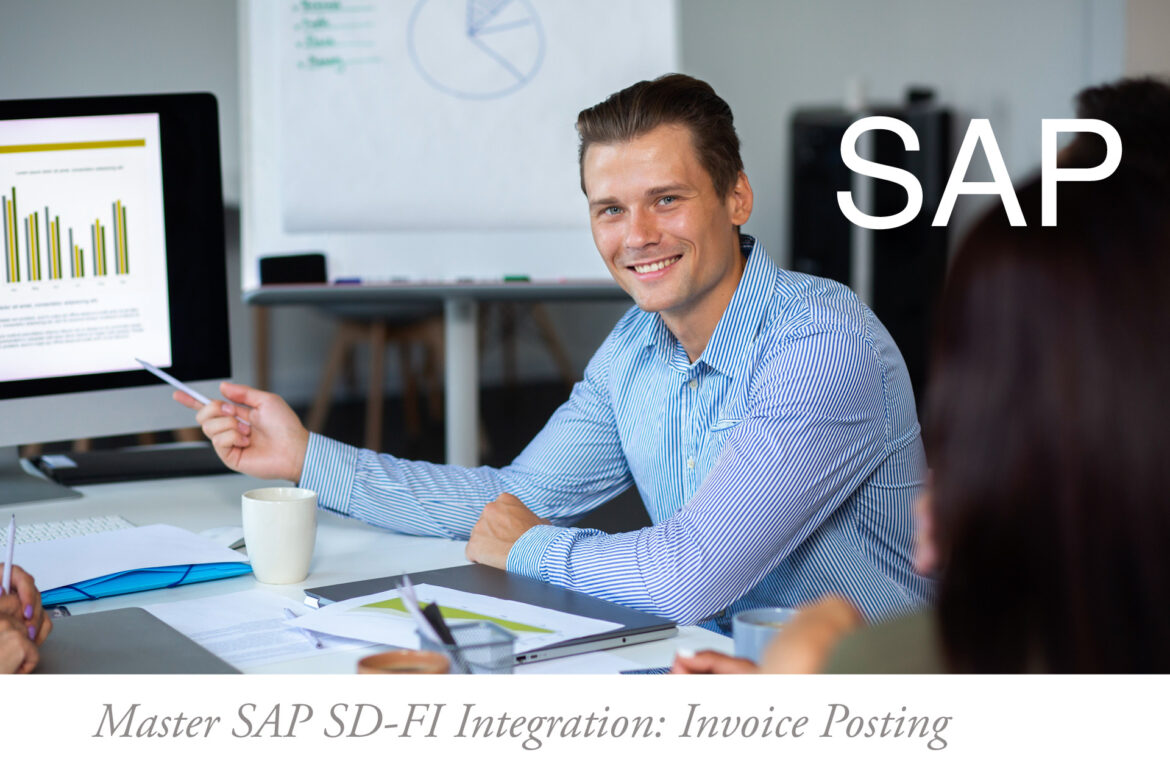Introduction
Imagine your sales team just closed a big deal. The customer is happy, the goods are shipped, and now it’s time to send the invoice and get paid! This seemingly simple step actually triggers a fascinating and crucial dance behind the scenes in SAP – a seamless integration between the Sales and Distribution (SD) module and the Financial Accounting (FI) module.
For anyone working with SAP, understanding this connection isn’t just for the technical gurus. It’s vital for sales managers to know how their orders become financial records, for finance teams to understand where revenue originates, and for consultants to troubleshoot issues.
In this blog post, we’ll demystify the core configurations that make this magic happen, walking you through the steps in a simple, human-centric way. We’ll even use an example to bring it to life!
Why the Integration is So Important
Before we dive into the “how,” let’s quickly touch on the “why.” Without this integration:
- No Revenue Recognition: Sales orders wouldn’t automatically become entries in your company’s general ledger, meaning you couldn’t officially track revenue.
- Billing Chaos: Imagine manually creating every invoice in finance after it’s processed in sales – a huge, error-prone mess!
- Lost Track of Receivables: You wouldn’t know who owes you money or how much, making cash flow management impossible.
- Inaccurate Reporting: Your financial statements (Profit & Loss, Balance Sheet) would be incomplete and unreliable.
Essentially, SD-FI integration turns a sales transaction into a recognized financial event, impacting your company’s books and allowing for accurate reporting.
The Core Idea: The Automatic Account Assignment (A.K.A. “The Secret Sauce”)
At the heart of SD-FI integration for invoice posting is something called “Automatic Account Assignment.” This is SAP’s way of figuring out which specific General Ledger (G/L) accounts in Finance should be hit when a sales invoice is created.
Think of it like a highly intelligent postal service. When a sales invoice (the letter) is created, this “postal service” (automatic account assignment) reads specific information on the invoice and automatically knows which financial mailboxes (G/L accounts like “Sales Revenue,” “Cost of Goods Sold,” “Accounts Receivable”) to deliver the financial impact to.
This “postal service” relies on a configuration setting called “VKOA” (yes, another classic SAP transaction code!).
Step-by-Step Configuration Simplified (The VKOA Breakdown)
Let’s break down the key settings within VKOA that dictate how your sales invoices hit your financial accounts.
To get there, you’d typically follow the SAP menu path:
SPRO > Sales and Distribution > Basic Functions > Account Assignment and Costing > Revenue Account Determination > Assign G/L Accounts
Or, simply type transaction code VKOA in the command field.
Once in VKOA, you’ll see a few different “tables” or “access sequences” you can configure. The most common and robust way to manage this integration is through the “Table 004: Cust Grp/Mat Grp/Acct Key” (Customer Group / Material Group / Account Key).
This table allows you to define rules based on:
- Application: Always “V” for Sales and Distribution.
- Condition Type: Always “KOFI” for General Ledger accounts.
- Chart of Accounts: The main list of G/L accounts your company uses (e.g., “INT” for International, or your company-specific chart).
- Sales Org.: Your Sales Organization (e.g., “1000”).
- Account Assignment Group – Customer: This is a key setting on the customer master record. It categorizes customers for revenue determination (e.g., “01” for Domestic Revenue, “02” for Export Revenue).
- Account Assignment Group – Material: This is a key setting on the material master record. It categorizes materials for revenue determination (e.g., “01” for Finished Goods, “02” for Services).
- Account Key: This is a crucial control key from your pricing procedure in SD. It determines what kind of financial transaction is occurring.
- ERL (Revenue): This is for the main revenue account.
- ERF (Sales Deductions/Freight): For discounts, surcharges, or freight if they need separate accounts.
- ERS (Sales Returns): For returns.
- And others for specific purposes.
- G/L Account: This is the actual financial account that will be posted to! (e.g., 400000 for Domestic Sales Revenue).
The Logic: SAP looks at these factors, finds a matching rule, and then posts to the specified G/L account.
Example: Selling a Widget
Let’s trace an example:
Our Scenario: Your company, “Global Widgets Inc.” (Sales Org 1000, Chart of Accounts INT), sells a “Super Widget” (Material 200001) to “Acme Corp.” (Customer 100001).
Step 1: Setup in SAP (Pre-configuration)
- Customer Master (Acme Corp. –
XD01/XD02):- Sales Area Data > Billing tab: Account Assignment Group – Customer = “01” (Domestic Customer)
- Material Master (Super Widget –
MM01/MM02):- Sales Org 2 data: Account Assignment Group – Material = “01” (Finished Good)
- Pricing Procedure (SD config –
V/08):- Your pricing procedure includes a condition type for basic price (e.g., “PR00”) which has an Account Key = “ERL” (Revenue).
- VKOA Configuration (the secret sauce!): You would have a VKOA entry like this:
| Application | Condition Type | Chart of Accts | Sales Org. | Acc. Grp Cust | Acc. Grp Mat | Acc. Key | G/L Account |
| V | KOFI | INT | 1000 | 01 | 01 | ERL | 400000 |
| V | KOFI | INT | 1000 | (blank) | (blank) | ERF | 500000 |
| … | … | … | … | … | … | … | … |
*This rule says: "If a sales invoice comes from Sales Org 1000, for a Domestic Customer (01) selling a Finished Good (01), and the line item is for main Revenue (ERL), then post to G/L Account 400000."*
Step 2: The Sales Process (VA01, VL01N, VF01)
- Sales Order Creation (
VA01): A sales order is created for “Acme Corp.” to buy a “Super Widget.” - Delivery Creation (
VL01N): The goods are picked, packed, and shipped. This often triggers the Cost of Goods Sold (COGS) posting to FI (another integration point, but not directly VKOA related). - Invoice Creation (
VF01): The billing document (invoice) is created.
Step 3: The Magic of Integration (Invoice Posting to FI)
When you save the invoice in VF01 (or if it’s done automatically):
- SAP looks at the invoice details: Sales Org 1000, Customer 100001 (Account Assignment Group 01), Material 200001 (Account Assignment Group 01), and the price line item has Account Key ERL.
- It finds the matching rule in
VKOA:V / KOFI / INT / 1000 / 01 / 01 / ERL - It sees the G/L account:
400000 - SAP automatically generates the following financial postings (visible in
FB03orFBL5N):- Debit: Accounts Receivable (Customer 100001) – $100.00 (This means Acme Corp. owes you money)
- Credit: Domestic Sales Revenue (G/L 400000) – $100.00 (This is your recognized income)
Other Key Integration Points (Briefly Mentioned)
While VKOA is central for revenue, other configurations ensure a complete financial picture:
- OBYC (Automatic Postings for Inventory Management): Handles the automatic G/L account determination for movements of goods (e.g., goods issue for delivery, goods receipt for purchase). This is where Cost of Goods Sold is posted.
- Pricing Procedure & Account Keys: As mentioned, the pricing procedure in SD defines the
Account Key(ERL, ERF, etc.) which is then used inVKOAto determine the specific G/L account. - Customer Master (Reconciliation Account): On the customer master record, a “Reconciliation Account” is specified. This is a G/L account (e.g., Accounts Receivable) that automatically accumulates all individual customer debit/credit entries, allowing finance to see the total amount owed by customers without having to sum up each individual customer account.
Troubleshooting Tips for SD-FI Integration
If your invoices aren’t posting to FI, or they’re hitting the wrong accounts:
- Check VKOA: This is your first stop! Is there a rule missing? Is an existing rule incorrect?
- Verify Master Data: Are the Account Assignment Groups correctly maintained on the Customer and Material Master records?
- Review Pricing Procedure: Does the correct Account Key (e.g., ERL) exist in your pricing procedure for the relevant condition types?
- Debug with ABAPer: For complex issues, an ABAP developer can “debug” the invoice creation process (
VF01) to trace exactly how SAP is trying to determine the accounts.
Conclusion
The integration between SAP SD and FI for invoice posting is a testament to SAP’s power in streamlining core business processes. By understanding the critical role of Automatic Account Assignment (VKOA) and its reliance on customer and material master data, pricing procedures, and account keys, you gain a clear picture of how a sales transaction seamlessly translates into accurate financial records.
This knowledge empowers you, whether you’re a sales professional, a finance analyst, or an SAP consultant, to ensure your company’s revenue is recognized correctly, its financials are pristine, and its operations run like a well-oiled machine. It’s the silent, steady heartbeat of every profitable sale!
External Links:
- Link to the official SAP Community Network (SCN) for further technical discussions or documentation. (e.g., https://community.sap.com/)




